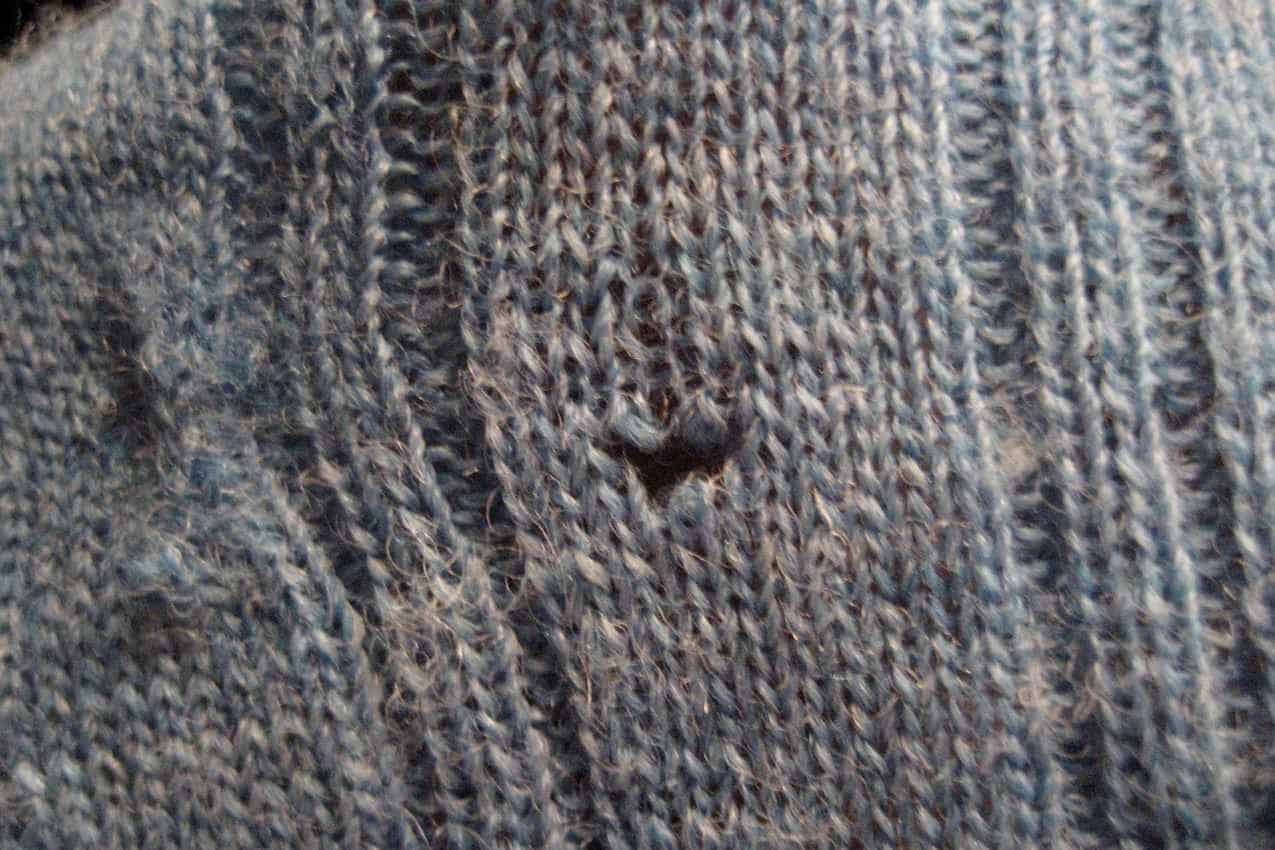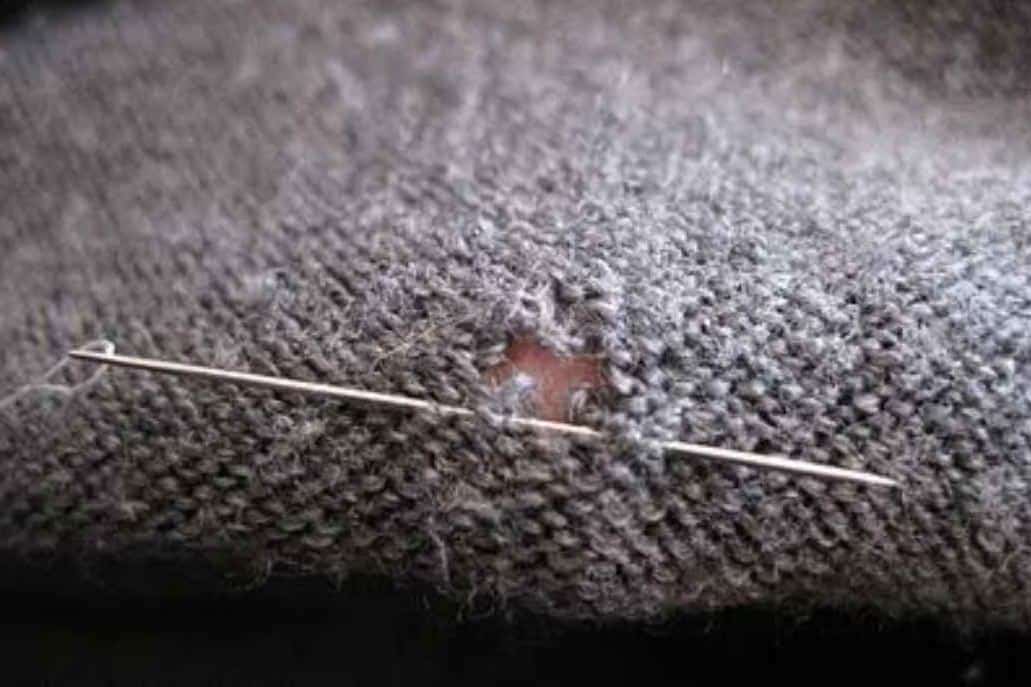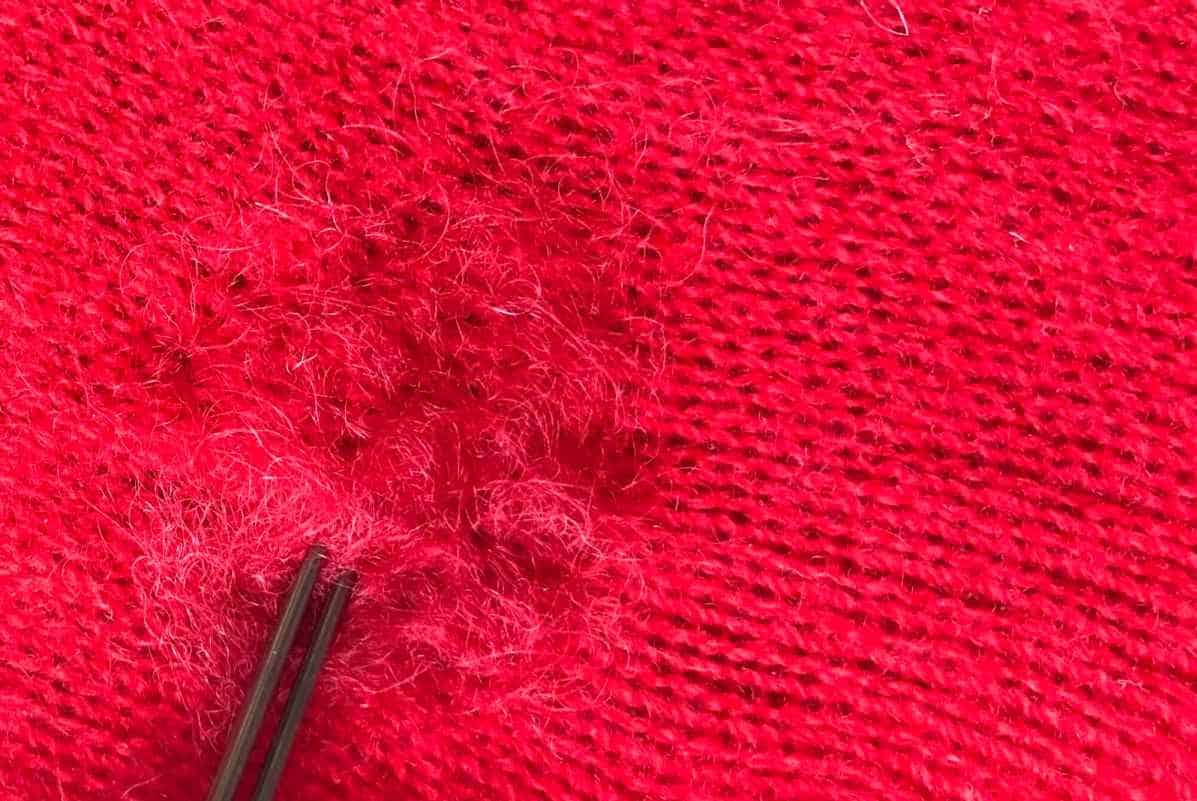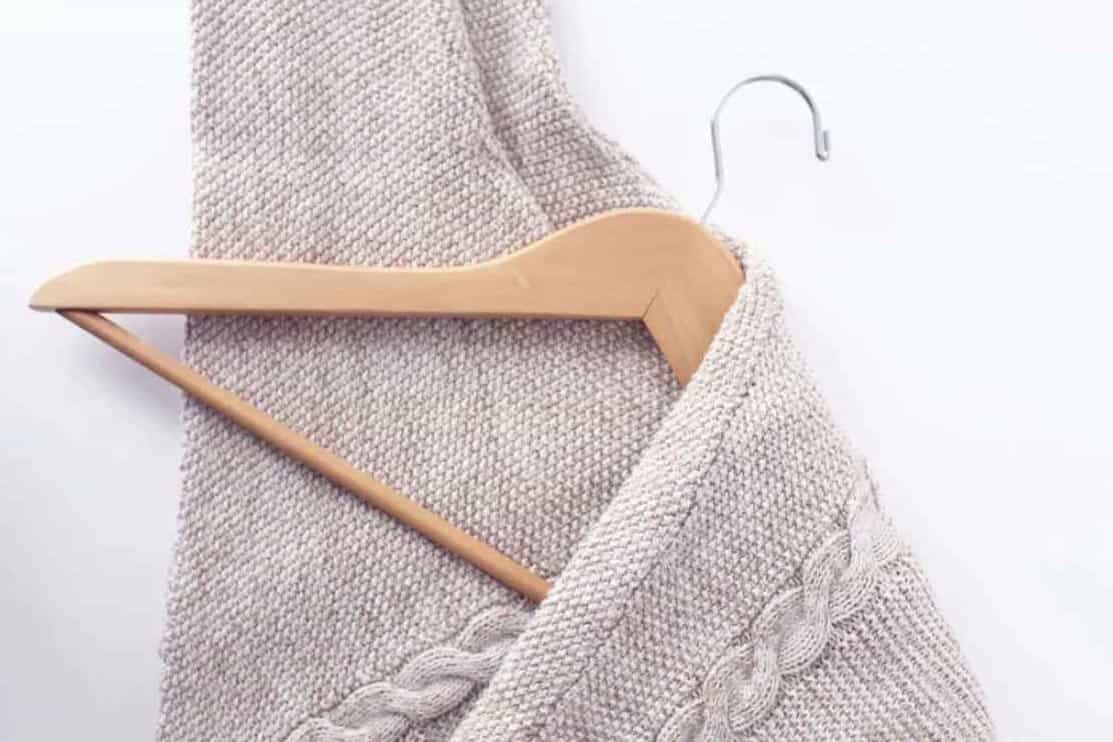Four holes – that’s all we need to fit in our clothes. But guess what? Nature has its way of adding more of it. Four turned five, and five turned to a dozen.
If your expensive wool clothing is a victim of this mishap, these four ways to mend holes in cashmere sweaters can bring back its glory. From the most basic to intricate handiwork, you can see it all in here.
Aside from repairs, we’ve also laid out what causes cashmere holes and some tips to prevent them from happening.
What Causes Holes In Cashmere Sweaters?
Seeing holes in your favorite cashmere sweater is downright heartbreaking. You’ve invested hard-earned money in good quality clothing, only to find out its damage already. But what’s the culprit of this wardrobe wreckage? Let’s spot some clues that might solve your cashmere sweater hole case.
- Clothes Moths: Check your wardrobes because there might be critters living inside them. Clothes moths are a common enemy of many households. They settle on unattended clothing to lay their eggs and provide vitamins for their larvae through the animal fibers. A bit icky if we were to say!
- Friction: Cashmere is soft to the touch and can make you feel like royalty. But along with this is a delicate fiber that can pill after friction. Pilling causes small fuzzballs to form that result from fabric breaking down. If it continues, it can lead to holes or a worn-out-looking cashmere.
- Chemical Treatments: If it’s your first time owning a cashmere, remember that fabric softener and chlorine bleach are their enemies. Why so? These chemical treatments are too harsh for delicate fabrics and can only cause pilling. And you know what’s next? Blight holes!
- Rough-Textured Accessories: It’s instinctive for many of us to wear accessories to complete our look. But be careful with your choice of embellishments. Metal parts on belts, zippers, or purses can snag on your cashmere, forming unwanted holes. Aside from this, continuous rubbing of canvas backpacks can ruin the fibers behind your sweater.
Hand Sewing Small Holes
The surefire way to repair small holes is through hand sewing. But don’t worry; this method does not need a ball of cashmere wool to use as a thread. Cotton thread is easier to color match and provides a cleaner finish.
Before you start sewing, you need to prepare the following materials first:
- Color-match cotton thread
- Sewing needle
- Scissors
If you have it all set, flip your sweater inside out. Although, you can have it the other way if you want to see the effect immediately while you’re stitching. Just make sure that the stitches are inside.
First, sew up underneath each side of the hole. Once you reach the last side, pick up one of the broken stitches. Then pull it up to its matching stitch, where it is separated away from. Continue picking up loose stitches and get everything lined up.
Quick reminder: When you’re sewing, don’t pull the thread too tight to prevent the fiber from bulging.
After a few loops, you’ll see the hole closing up. But we’re not done yet! To completely fix the gaps, zigzag across the vertical thread several times.
Once satisfied, close the thread by circling the hole, as you did in the first part. Cut it with the scissors, and now you’ve got one cashmere sweater repaired.
Repairing Small Holes With Fusing Powder
Not confident with you’re sewing skills? No worries because this method is (for sure) right up your alley. It does not require sewing, although you’ll need more equipment than the previous one.
Here’s the list of tools you need to prepare prior:
- Fusing Powder
- Color-match cashmere wool
- Color-match fabric (for the patch)
- Non-stick fiberglass sheet
- Iron
- Ironing board
Buying cashmere wool is expensive for small-hole repair. That’s why we’re sharing a way to get it for free. Here’s how:
Turn your sweater inside out. Look for an area sewn together with extra fabric poking out. Once you spot one, trim a thin piece enough to cover the hole. Be careful not to cut close to the stitching if you don’t want to end up with another damage.
Roll the acquired piece into a ball and chop it with a scissor. It should create more fluff for an identical look to the sweater. After fluffing, sprinkle it with fusing powder and roll it again in a little ball.
Place the fabric ball in the hole, then add more fusing powder. Cover it with a color-match fabric, and blow away excess powder around it.
Once settled, put the fiberglass sheet on top and start ironing. Keep the iron pressed for a few seconds before doing it on the other side.
Quick reminder: When ironing, keep the fiberglass on both sides to prevent burning.
Repairing Small Holes Through Needle Felting
Vintage cashmere sweaters deserve intricate handiwork to repair. But with quick fixes dominating the web, it’s hard to locate a non-visible mending solution for high-quality fabrics.
Luckily, there is one method that can match the timeless clothing piece. The technique is named needle felting, which uses specially designed needles to manipulate the wool fibers. If you plan to try this technique, here’s what you’ll need:
- Felting wool
- Felting mat/ brush or foam block
- Multi-needle felting tool
- Scissor
If you own a lot of cashmere fabrics, investing in those tools would come in handy. Now onto the repair, friends, and folks.
Locate the hole in your sweater and place it above the felting brush. Then, take a few felting wool fibers enough to cover the void. Pull the fibers apart and cross them from each other, molding them into a loose circle.
Place the fibers on top of the hole, and push it down using the multi-needle felting tool. Do this until it looks well meshed within the fabric. Turn the sweater inside out, and repeat the process. For long fibers, you can trim it with a scissor.
Quick reminder: Keep the multi-needle felting tool at 90 degrees to avoid breakage.
You may add more fibers if the initial trial missed a little space. After poking the wool through, expect some lumps on the garment. To remove it, use an iron (on the wool setting) to help set the fibers and tighten the bind. Now, you have a newly-looking cashmere sweater.
Patching Up the Big Holes
Do you have a prized possession cashmere sweater stowed away at the back of your closet?
While it’s good memorabilia, hiding it in the darkest spot of your room can only add more holes to it. (No thanks to clothes moth who loves munching on woolen fabric).
So to save stress, why not bring it back to life by patching it up? All you need are the following:
- Identical fabric
- Needle
- Cotton thread
- Scissors
Finding an identical fabric to your cashmere sweater can be tricky. But if you’re not keen on keeping the aesthetic, you can patch it with other designs. That way, you can also add some character to your sweater.
First, you need to cut the patch in a circle. Once shaped, place it on the wrong side of the sweater, covering the big hole. Anchor the thread on the garment to your patch until the whole sides are sewn. For this, you can do a simple blanket stitch or apply the pattern you’re comfortable with. Lastly, iron the sweater in a wool setting to flatten the repair.
Tips to Prevent Holes in Your Cashmere Sweater
Get ahead of the cause if you don’t like repairing your cashmere sweater regularly. Here are some tips to follow for hassle-free maintenance.
Proper Washing
Hand washing is one of the best ways to clean your cashmere. But if you don’t have time, you can use the washer while following some of the listed notes:
- Run it under wool or delicate cycle.
- Use a mild detergent and set the temperature to 30 degrees or less.
- Avoid washing it with garments that have sharp edges (like zippers or bra hooks).
It is also essential to know that cashmere sweaters don’t need constant washing. Laundering is recommended after three wears as long as it is not heavily soiled.
Proper Storage
Cashmere is not meant to be hung on wardrobes like your polos. Hanging can stretch the fibers and loosen their structure. Instead, fold it after drying to maintain its shape. But if you’re small on space, fold the arms and hang it like you would on pants.
Use Natural Moth Killer
Clothes smelling like pesticide is the worst thing you wouldn’t want to happen. To repel these hole-making pests, place rosemary, lavender, or bay leaves in a cloth bag. Hang it on your wardrobe and watch as the moths move out.
Spraying an oil form of these scents can also help prevent moths from settling in.
Conclusion
Clothes bring bliss and delight to some of us. But the complete opposite occurs when we see our clothes damaged.
If you’ve experienced wardrobe mishaps, we hope these four ways to mend holes in cashmere sweaters can help you. After all, being able to wear your hard-earned piece again is satisfactory in itself.

Jessica Oliver is a fashion enthusiast with more than ten years of experience in the industry. She previously managed her own clothing store in New York before becoming a mother of three. With a passion for sustainability and a desire to share clothing care and recycling tips.






